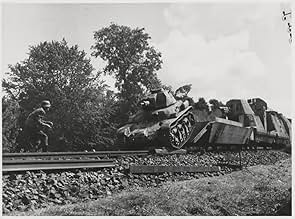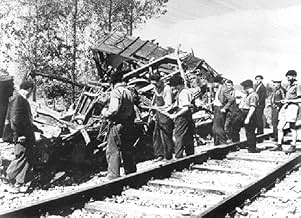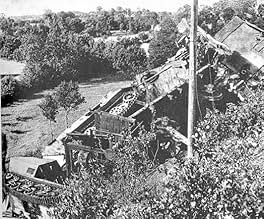AVALIAÇÃO DA IMDb
7,0/10
1,4 mil
SUA AVALIAÇÃO
Na prática uma homenagem aos ferroviários franceses que integraram a luta da Resistência na Segunda Guerra. Embora contada como uma história única, é na verdade uma espécie de colagem de eve... Ler tudoNa prática uma homenagem aos ferroviários franceses que integraram a luta da Resistência na Segunda Guerra. Embora contada como uma história única, é na verdade uma espécie de colagem de eventos diversos que ocorreram durante o conflito.Na prática uma homenagem aos ferroviários franceses que integraram a luta da Resistência na Segunda Guerra. Embora contada como uma história única, é na verdade uma espécie de colagem de eventos diversos que ocorreram durante o conflito.
- Direção
- Roteiristas
- Artistas
- Prêmios
- 3 vitórias e 1 indicação no total
Marcel Barnault
- Cheminot
- (as Barnault)
Jean Clarieux
- Lampin
- (as Clarieux)
Jean Daurand
- Cheminot
- (as Daurand)
Lucien Desagneaux
- Athos
- (as Desagneaux)
François Joux
- Cheminot
- (as Joux)
Pierre Latour
- Cheminot
- (as Latour)
Robert Le Ray
- Chef de gare
- (as Leray)
Pierre Lozach
- Cheminot
- (as Lozach)
Pierre Mindaist
- Cheminot
- (as Mindaist)
Léon Pauléon
- Chef de gare St-André
- (as Pauleon)
Fernand Rauzéna
- Cheminot
- (as Rauzena)
Michel Salina
- Allemand
- (as Salina)
Charles Boyer
- Narrator
- (narração)
- (não creditado)
- Direção
- Roteiristas
- Elenco e equipe completos
- Produção, bilheteria e muito mais no IMDbPro
Avaliações em destaque
This movie is not great. It's good, and it's only ok if you've already seen The Train 1964. This 1946 movie is artistic, stark, neo realist, blah blah, like many post war European made movies from the era. But it lacks character study and has only tactical measures and rebelliousness against not-so-evil Nazis as the reason for being, unlike The Train.
Army of Shadows 1969 is another example of a refined, not-so-purist remake of previous movies. It was just done better and had a longer lasting impact, like The Train.
But telling fans of La Bataille Du Rail that it's overrated just gets a lot of dislikes. Examine both movies yourself, but make sure you watch the 1946 movie FIRST so you won't be disappointed.
Army of Shadows 1969 is another example of a refined, not-so-purist remake of previous movies. It was just done better and had a longer lasting impact, like The Train.
But telling fans of La Bataille Du Rail that it's overrated just gets a lot of dislikes. Examine both movies yourself, but make sure you watch the 1946 movie FIRST so you won't be disappointed.
I usually stop watching films when I discover that it has subtitles but I'm glad that I didn't with this one. Stopping German supplies and reinforcements reaching Normandy contributed greatly to the advancement of the Allies, many trains, and rail tracks, were destroyed by the RAF in the run up to the invasion but the events in this film also helped greatly.
After the war the French were very keen to show that they didn't just capitulate ASAP but had an active resistance movement but in the many WWII history books I've read their overall contribution to the victory In Europe is considered to be minimal.
Regardless of that this film is very well worth watching.
After the war the French were very keen to show that they didn't just capitulate ASAP but had an active resistance movement but in the many WWII history books I've read their overall contribution to the victory In Europe is considered to be minimal.
Regardless of that this film is very well worth watching.
Although there have been more nuanced, psychologically penetrating filmic depictions of French resistance under Nazi occupation, none has matched the sheer immediacy of René Clément's feature film debut. It represents a natural progression from his pre-war documentaries and indeed the early part is filmed in a documentary style with no clear delineation of character but changes tack dramatically when news comes through of the Allied landings and the Maquis plan greater acts of sabotage to prevent the Germans from moving armoured trains to Normandy.
Based upon real events and featuring many of the courageous participants in the Battle of the Rails of 1944, Clément uses cinéma vérité techniques and Russian-style montage to build momentum and suspense, culminating in the unforgettable derailment of the train convey which is shot from three different angles. Suffice to say the film's most powerful scene is the execution by firing squad of six randomly chosen railway workers. This is a superlative combination of image and sound as their deaths are accompanied by trains whistling in defiance. The post-sync dubbing of the mainly non-professional cast is pretty good and this viewer at any rate is intrigued as to who supplied the German voices. Clément has also been sure to use the strongest, most characterful faces for the close-ups.
It seems that the French suffered from collective amnesia following the liberation and Clément made a brave call for his film might have come too soon and been too close to home but its triumphalism ensured its great critical and commercial success whilst arguably paving the way for Alexander Esway's hugely popular 'Le Bataillon du Ciel' the following year. One cannot help but wonder whether John Frankenheimer was aware of this film when making 'The Train' twenty years on.
As well as being a moving testament to the kind of bravery of which very few are capable it marks, on a purely filmic level, the emergence of a special directorial talent that was to go from strength to strength.
Based upon real events and featuring many of the courageous participants in the Battle of the Rails of 1944, Clément uses cinéma vérité techniques and Russian-style montage to build momentum and suspense, culminating in the unforgettable derailment of the train convey which is shot from three different angles. Suffice to say the film's most powerful scene is the execution by firing squad of six randomly chosen railway workers. This is a superlative combination of image and sound as their deaths are accompanied by trains whistling in defiance. The post-sync dubbing of the mainly non-professional cast is pretty good and this viewer at any rate is intrigued as to who supplied the German voices. Clément has also been sure to use the strongest, most characterful faces for the close-ups.
It seems that the French suffered from collective amnesia following the liberation and Clément made a brave call for his film might have come too soon and been too close to home but its triumphalism ensured its great critical and commercial success whilst arguably paving the way for Alexander Esway's hugely popular 'Le Bataillon du Ciel' the following year. One cannot help but wonder whether John Frankenheimer was aware of this film when making 'The Train' twenty years on.
As well as being a moving testament to the kind of bravery of which very few are capable it marks, on a purely filmic level, the emergence of a special directorial talent that was to go from strength to strength.
Rene Clement's first feature about the French rail workers who under the strangle hold of the dirty Nazis put up a fight by causing chaos with the running of the trains. A neo-realist style with unprofessional actors.
For cinema enthusiasts, it is important to learn that the value of trains in the field of cinema has always been justly understood by filmmakers as truthful portrayals of trains have been extremely useful in making films which have become extremely popular with critics as well as with viewers. It would be appropriate to state that most of the films about war have an air of authenticity due to the realistic depiction of trains in them. It would not be an exaggeration to state that war films are popular due to the portrayal of trains in them. La Bataille Du Rail/The Battle of the Rails is the best example of a war film with trains and their impact on war as its major plot. The success of this film is due to the efforts of ordinary railway workers in war time France who were quick to realize that the damage to railway system in occupied France would be a key weapon in their fight against Nazi Germany. Those who favor technology in cinema would be shocked to learn how professionally the massive annihilation of trains was carried out in "The Battle of the Rails" despite the evident lack of technology. In 1946, this film by René Clément won a jury prize at Cannes Film Festival. In recent times, La Bataille Du Rail/The Battle of the Rails has been hailed as one of the classics of world cinema as it was shown in "Cannes Classics" section during 63rd Cannes International Film Festival held in 2010. Hardcore cinema enthusiasts would be thrilled to learn that it has been fully restored by INA in France where it can also be watched on DVD as well as Blu Ray formats.
Você sabia?
- CuriosidadesIn part financed by what had been the Resistance as a way of showing international audiences what the French population had been facing under Nazi oppression. The Resistance was also keen to let the world know that they had been actively involved in disrupting the German war machine in France as the international perception at the time was that the French had capitulated and collaborated a little too easily with their Nazi captors.
- Erros de gravaçãoRailway worker tapping Morse code just repeats letter "V" most of the time with only a few exceptions.
- Cenas durante ou pós-créditos(in cast) et Les cheminots de France
- ConexõesFeatured in Cannes... les 400 coups (1997)
Principais escolhas
Faça login para avaliar e ver a lista de recomendações personalizadas
- How long is The Battle of the Rails?Fornecido pela Alexa
Detalhes
- Data de lançamento
- País de origem
- Central de atendimento oficial
- Idiomas
- Também conhecido como
- The Battle of the Rails
- Locações de filme
- Gare SNCF, Saint-Brieuc, Côtes-d'Armor, França(first scenes, train station)
- Empresas de produção
- Consulte mais créditos da empresa na IMDbPro
- Tempo de duração1 hora 25 minutos
- Cor
- Mixagem de som
- Proporção
- 1.37 : 1
Contribua para esta página
Sugerir uma alteração ou adicionar conteúdo ausente

Principal brecha
By what name was A Batalha dos Trilhos (1946) officially released in Canada in English?
Responda



















